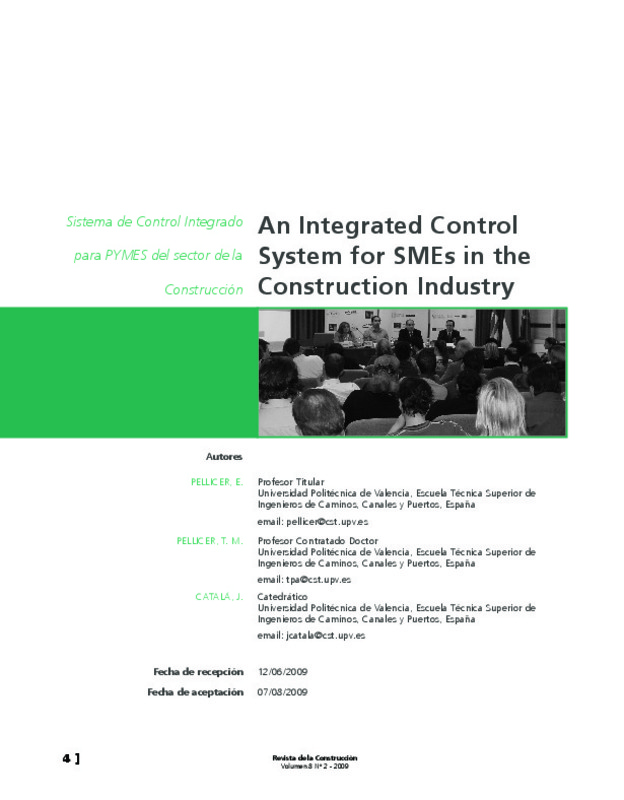|
Resumen:
|
[EN] Most construction companies are small and medium-sized enterprises (SMEs) that manage project-based and businessfocused activities simultaneously. Commercial software packages are not fully developed to offer a unique ...[+]
[EN] Most construction companies are small and medium-sized enterprises (SMEs) that manage project-based and businessfocused activities simultaneously. Commercial software packages are not fully developed to offer a unique solution that tackles both. To fill this gap, this paper describes an integrated management system specifically developed for SMEs in the construction industry, whether contractors or consulting engineering and architectural firms. Both, project and business functions are addressed and handled by the system as a whole. Particular attention is given to the
procurement process because it is essential for the strategic planning of these companies, which must naturally engage new contracts to remain in business. The system is based on a client/
server architecture that is arranged in three tiers: presentation (user interfaces and forms), application (queries), and data (relational tables). The system uses MS AccessTM as a database management system. Users are categorized according to their functions within the hierarchy
of the company, and therefore several different interfaces are designed for each personnel category. The system works in real-time, so every employee with a preestablished right of access can obtain information instantaneously. This is crucial for making immediate decisions when
problems arise, allowing prompt actions from every manager in the hierarchy and resulting in noteworthy time savings. This computer-based application has been successfully implemented by four Spanish SMEs in the construction industry. The suitability and advantages of the system
implementation are highlighted in this paper with specific data regarding its current operation.
[-]
[ES] La mayor parte de compañías de la industria de la construcción son pequeñas y medianas empresas (PYMEs) que gestionan simultáneamente actividades basadas en los proyectos y en los
negocios. Las aplicaciones informáticas ...[+]
[ES] La mayor parte de compañías de la industria de la construcción son pequeñas y medianas empresas (PYMEs) que gestionan simultáneamente actividades basadas en los proyectos y en los
negocios. Las aplicaciones informáticas comerciales no se han desarrollado suficientemente para ofrecer una solución única que aborde ambos aspectos. Con el fin de cubrir esta carencia, el presente artículo describe un sistema integrado de gestión diseñado específicamente para PYMEs del sector de la construcción, sean constructoras o consultoras de ingeniería y arquitectura. Ambas funciones, proyectuales y empresariales, son abordadas y gestionadas conjuntamente por el sistema. Especial atención origina el proceso de contratación debido a que es fundamental para la planificación estratégica de estas empresas, las cuales deben conseguir nuevos contratos con
el fin de mantenerse en el mercado. El sistema está basado en una arquitectura cliente/servidor que se estructura en tres niveles: presentación (interfaces del usuario y formularios), aplicación (consultas) y datos (tablas relacionales). Se utiliza MS AccessTM como sistema gestor de la base de datos. Los usuarios se categorizan de acuerdo con sus funciones dentro de la jerarquía empresarial y, por lo tanto, se diseñan diferentes interfaces para cada categoría de personal. El sistema trabaja en tiempo real, de modo que cada empleado, con sus derechos de acceso preestablecidos, puede obtener información instantáneamente. Este aspecto es fundamental para tomar decisiones inmediatas cuando surgen los problemas, permitiendo que los gestores en cualquier nivel jerárquico actúen rápidamente, y obteniendo ahorros de tiempo sustanciales. Esta aplicación informática se ha implementado con éxito en cuatro empresas españolas del sector de la construcción. La adaptabilidad y ventajas del sistema se destacan en el artículo, incluyendo datos concretos sobre
su funcionamiento real.
[-]
|
|
Agradecimientos:
|
The beta version of the computer program was tested at Iva-Leying, a Spanish SME. The research described in this paper was partially funded by the Spanish Ministry of Infrastructures through grant 2004-36. We wish to thank ...[+]
The beta version of the computer program was tested at Iva-Leying, a Spanish SME. The research described in this paper was partially funded by the Spanish Ministry of Infrastructures through grant 2004-36. We wish to thank both organizations for their support, and also Debra Westall and Salvador Palanca for revising the text.
[-]
|







